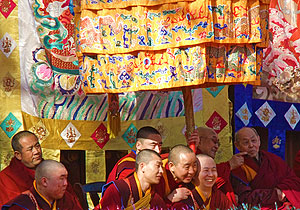Lama Temple

Beijing's Lama Temple (Yonghe) is regarded as one of the most important Tibetan Buddhist monasteries in the world. Located in the northeast Dongcheng district, it serves as a monastery for the Geluk School of Tibetan Buddhism and is the largest in China.
Constructed in 1694 during the Qing Dynasty, it was originally the residence for court eunuchs but was changed to Emperor Yongzheng's residence while he was still a prince. When he became Emperor, he converted half into a Lamasery and kept the other half as an Imperial Palace. After Yongzheng's death in 1735, the following Emperor Qianlong gave the temple imperial status and changed the roof tiles to the royal yellow. In 1744 he converted the temple to a Lamasery and it became the residence for many monks from Tibet and Mongolia.
The temple itself is noted for its mix of Han and Tibetan architecture aswell as some Mongolian influence. Designed on a straight north-south axis, it has five main buildings and five courtyards in a row as well as pavilions, towers, statues etc. within its walls.
Walking through the first courtyard, you pass a bell and drum tower going to the Hall of the Heavenly Kings (Tianwangdian), which was the original entrance and has a statue of the Maitreya Buddha and the four heavenly kings. Next, the Hall of Harmony and Peace (Yonghegong) is the main building and houses statues of three Buddhas of the ages and 18 arhats. The Hall of Everlasting Protection (Yongyoudian) was where the emperor lived as a prince and now holds a statue of the healing Buddha.
Moving on, the Hall of the Wheel of Law (Falundian) is the Lama ceremonial hall and has a statue of Tsong Khapa, the father of the Yellow Hat Sect of Tibetan Buddhism as well as 500 arhats made of various metals. Finally, the Pavilion of Ten Thousand Happinesses (Wanfuge) is the largest building and houses the largest wooden Buddha carving in the world, a 26m high Maitreya Buddha carved from a single sandalwood tree.